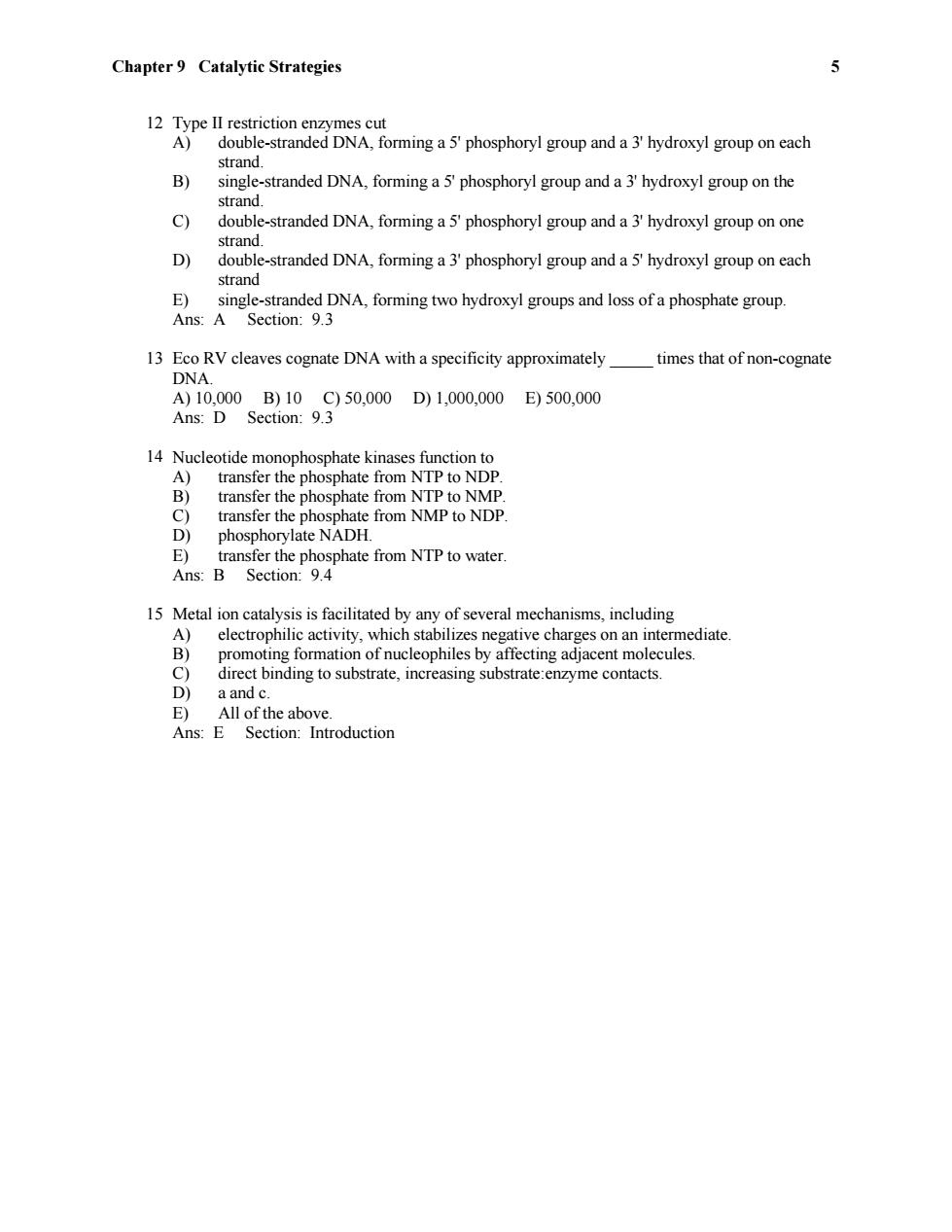正在加载图片...

Chapter 9 Catalytic Strategies 5 12 Type II restriction enzymes cut A)double-stranded DNA,forming a 5'phosphoryl group and a 3'hydroxyl group on each strand. B) single-stranded DNA,forming a 5'phosphoryl group and a 3'hydroxyl group on the strand. C) double-stranded DNA,forming a 5'phosphoryl group and a 3'hydroxyl group on one strand. D) double-stranded DNA,forming a 3'phosphoryl group and a 5'hydroxyl group on each strand E)single-stranded DNA,forming two hydroxyl groups and loss of a phosphate group. Ans:A Section:93 13 Eco RV cleaves cognate DNA with a specificity approximately times that of non-cognate DNA. A)10,000B)10C)50,000D)1,000,000E)500,000 Ans:D Section:9.3 14 Nucleotide monophosphate kinases function to A)transfer the phosphate from NTP to NDP. B) transfer the phosphate from NTP to NMP. C) transfer the phosphate from NMP to NDP. D) phosphorylate NADH. E) transfer the phosphate from NTP to water. Ans:B Section:9.4 15 Metal ion catalysis is facilitated by any of several mechanisms,including A) electrophilic activity,which stabilizes negative charges on an intermediate. B) promoting formation of nucleophiles by affecting adjacent molecules. C) direct binding to substrate,increasing substrate:enzyme contacts. D) a and c. E)All of the above. Ans:E Section:IntroductionChapter 9 Catalytic Strategies 5 12 Type II restriction enzymes cut A) double-stranded DNA, forming a 5' phosphoryl group and a 3' hydroxyl group on each strand. B) single-stranded DNA, forming a 5' phosphoryl group and a 3' hydroxyl group on the strand. C) double-stranded DNA, forming a 5' phosphoryl group and a 3' hydroxyl group on one strand. D) double-stranded DNA, forming a 3' phosphoryl group and a 5' hydroxyl group on each strand E) single-stranded DNA, forming two hydroxyl groups and loss of a phosphate group. Ans: A Section: 9.3 13 Eco RV cleaves cognate DNA with a specificity approximately _____ times that of non-cognate DNA. A) 10,000 B) 10 C) 50,000 D) 1,000,000 E) 500,000 Ans: D Section: 9.3 14 Nucleotide monophosphate kinases function to A) transfer the phosphate from NTP to NDP. B) transfer the phosphate from NTP to NMP. C) transfer the phosphate from NMP to NDP. D) phosphorylate NADH. E) transfer the phosphate from NTP to water. Ans: B Section: 9.4 15 Metal ion catalysis is facilitated by any of several mechanisms, including A) electrophilic activity, which stabilizes negative charges on an intermediate. B) promoting formation of nucleophiles by affecting adjacent molecules. C) direct binding to substrate, increasing substrate:enzyme contacts. D) a and c. E) All of the above. Ans: E Section: Introduction